A Kruger Adventure: Satara Rest Camp
After an early dinner, we took a stroll around the camp and found our path being crossed by fierce feline: the mighty but small African Wild Cat.
17-December-2022
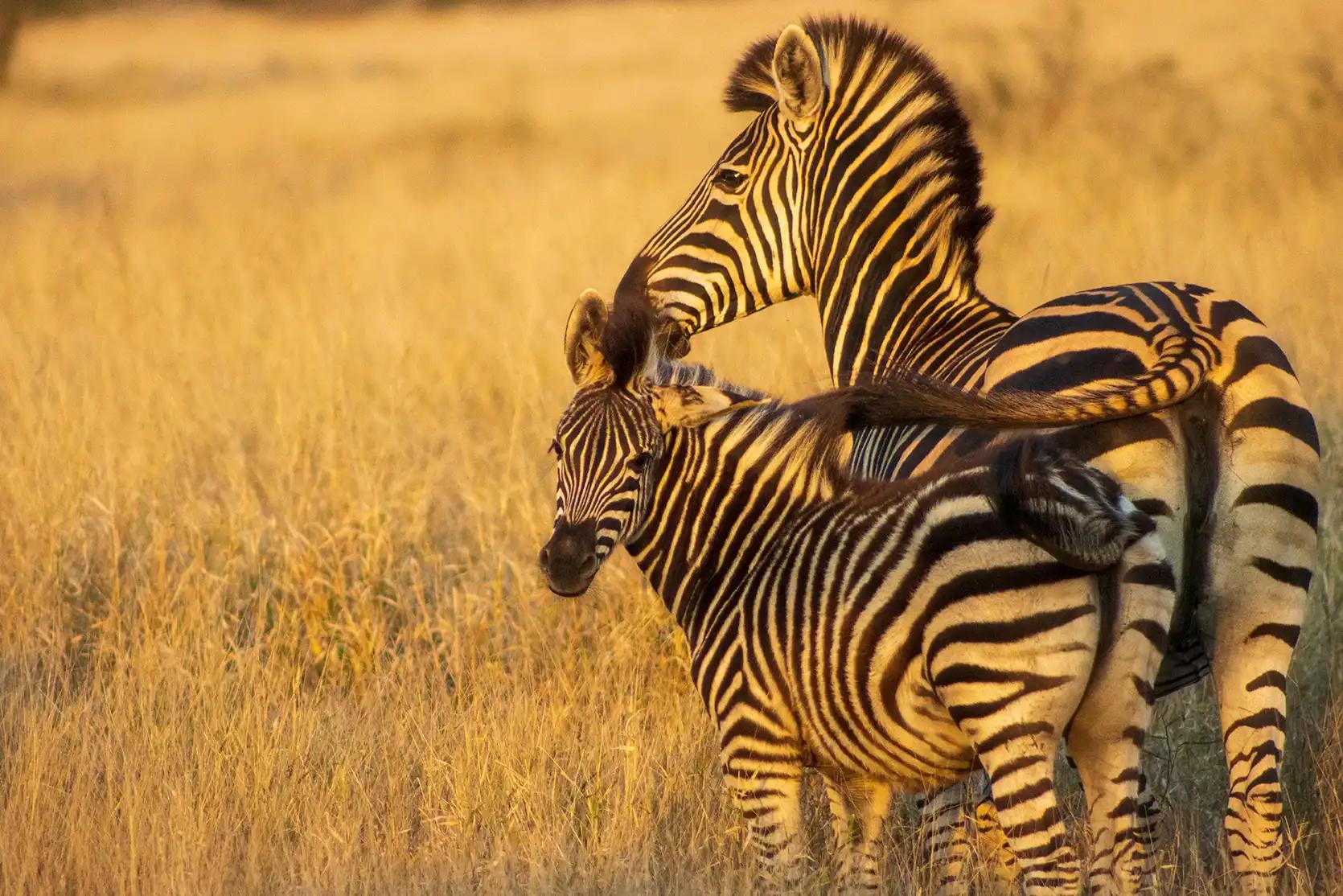
We drove through Orpen gate and into the Kruger at lunchtime, our eyes immediately darting from the ground, into the tall grass and up into the tops of the trees, trying to perceive the minutest of movements. Quite quickly, we were greeted by a lone elephant near the side of the road, lazily enjoying a late lunch. Eager to find our rest camp, Satara, we drove at a reasonable pace - surely missing some fantastic sightings in the process. We did pass by numerous buck, zebras and a family of giraffes. With every sighting, we grew more excited, snapping photos and ticking them off the Kruger Explorer app's sightings list. The app is a must for anyone staying in the park and going at it alone.
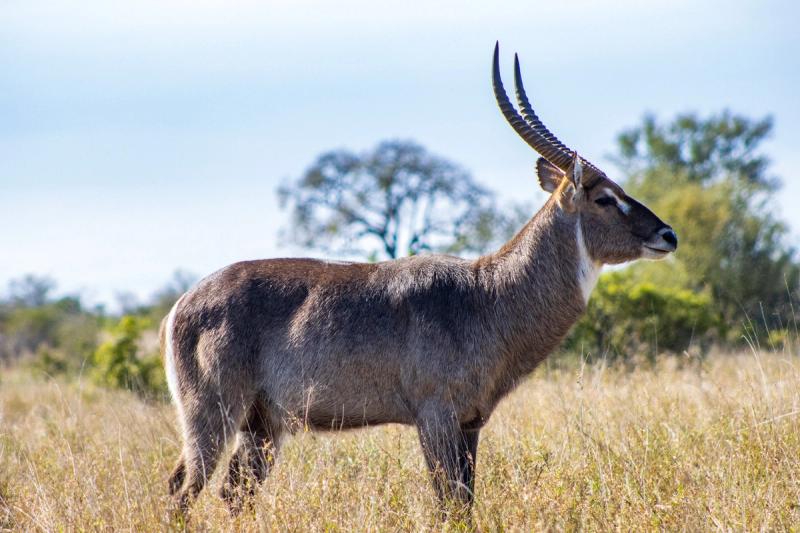
Somewhere between Orpen and Satara, we spotted a car parked near a bend in the road. We quietly pulled up behind them and between the thicket, spotted a giant grey elephant. Slightly ahead of the car in front of us, were more elephants. We pulled ahead, further around the bend and as the elephants moved, we ended up right alongside them watching as their mighty trunks wrapped around branches, crunching them as they tore them down with ease. Suddenly one emerged from the bush just three meters from the car, its ears fanning - obviously unhappy with our close presence. We moved on not wanting to upset it further.
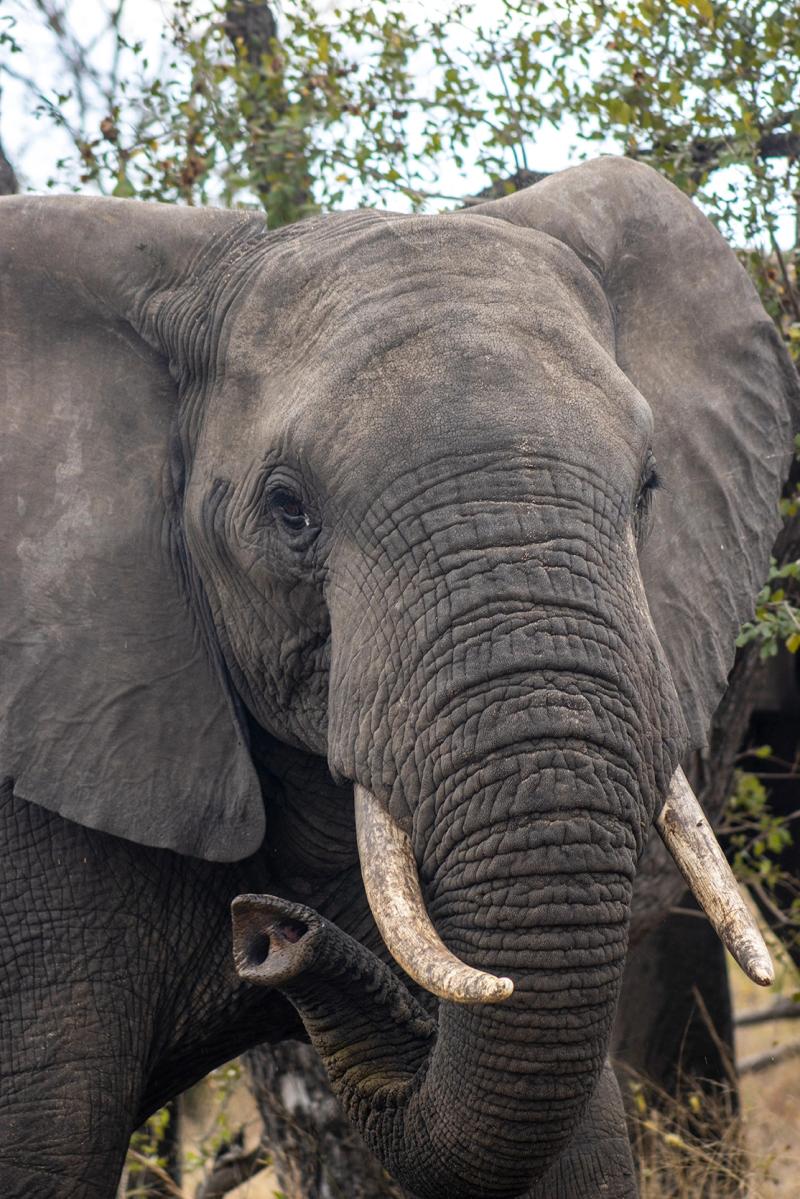
Roughly 20km from Satara, we spotted a large band of cars stopped alongside the road. Pulling up next to them, we craned our necks, desperate to see what they were seeing. After eyeing the tall grass for several minutes, we moved a few meters forward and asked a couple in another car what we were looking for. “A cheetah” they replied. There was one lying in the grass. We spent a few more minutes trying to spot the spotted feline before giving up. As we drove off with my eyes still firmly fixed on the grass-line, I noticed two small black spots sticking out. We’d finally spotted it!
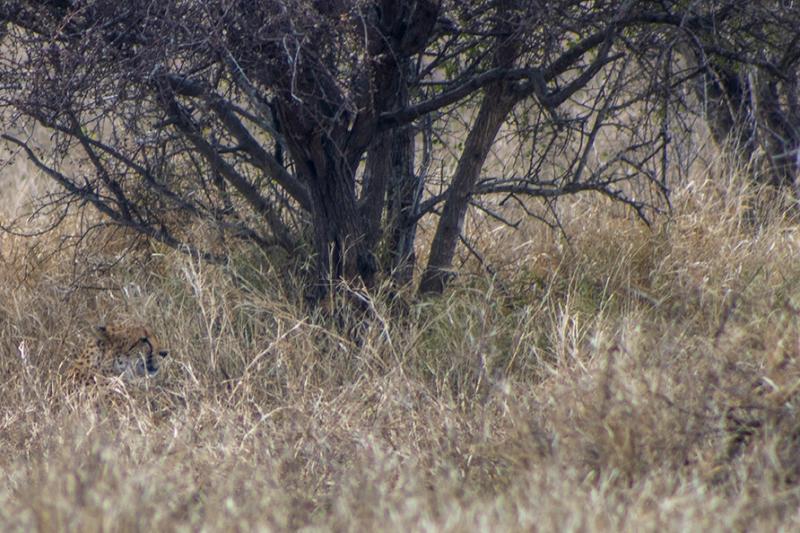
It sat in the grass, its head barely visible. I had to zoom in with my camera lens to see it properly. After a minute or two, we left, passing an empty looking Nsemani Dam on our way. It was mid-afternoon but we’d finally arrived.
Satara Rest Camp
Facilities
The cat camp, as Satara affectionately known, is a large camp in the southern portion of the park. Surrounded by open grassy plains and savannah, the camp’s nearby routes offer plenty of opportunities to sight large and small herbivores, birds of prey and wild cats. The camp boasts a swimming pool, children’s playground, laundromat and gas station. There’s a shop on site where you can purchase almost everything you could possibly need and those forgotten necessities. You can also purchase fruit, veg, meat and an array of snacks but if you don’t feel like firing up the braai, there’s also a Cattle Baron’s restaurant on site.
Our experience
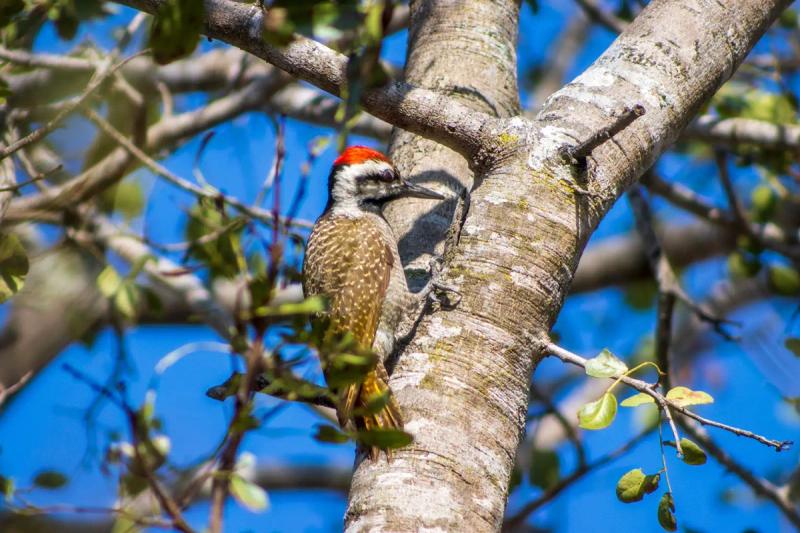
We spent the four nights of our five nights at the Kruger National Park at Satara in a rondavel-style bungalow fitted with two single beds, an air-conditioning unite, a shower and washbasin. A small kitchen complete with stove, fridge, pans and enough utensils for two could be found on the outside stoep along with a table and some chairs. Leading away from the bungalow was the short path to our braai.
Each night, after marvelling at the tapestry of stars that punctuated the night sky and formed the Milky Way, we'd fall asleep on the surprising firm mattresses, listening to the sounds of the animal kingdom that surrounded us. We braai-ed on two of the four nights, eating left overs the other times or at Cattle Barons and snacking on savoury and sweet treats on our drives.
Our room was cleared each day and our belongings respected except by the vervet monkeys who riffled through our trash in search of left over food and who, had we not locked the fridge and cupboards, would have escaped with a bigger bounty. Apart from yoga doing vervet monkeys, we were also privy to a bearded woodpecker, a brown-headed parrot, an African wild cat and hone badger sighting. And all within metres from our front door!

What we liked about Satara was that even though it's one of the larger camps in the southern part of the Kruger, it's not the largest and doesn't feel overly commercialised like some of the others. While our rondavel was easy to find in the daylight, the circular layout became incredibly confusing when we returned from a sunset safari and went in literal circles, our eyes darting from the map to the numbers on the huts as we tried to find the right one.
All in all, we loved Satara and would stay there again in a heart beat.
Exploring the Kruger from Satara
Self-drive Safari
Before arriving, we'd looked at different maps, not to plan our routes but so we'd have something to refer to and guide as as we drove around on our own hoping for the best. It was in this initial stage of research that I stumbled upon the Kruger Explorer app, built by Danny and Charlotte. For only R200, it gave you lifetime access to the app with offline maps, suggested itineraries and a checklist so you can keep track of all your sightings.

After settling in and depositing our bags, armed with the app - and having ticketed off a few animals already - we headed out for a quick drive in hopes of spotting some lions or a leopard. We headed back towards the hippos as they were close enough to our rest camp that the risk of us being late for the gate closing was slim. With nothing else in sight, we parked by the Nsemani dam and watched the hippos frolicking in the water before calling it a night.
S100 Loop
After a nap (we'd had an early start with the morning guided bush walk) and a late breakfast, we did the S100 loop. The long, slightly winding route is surrounded by open savannah plains and is known as a regular hangout for the park's feline families.
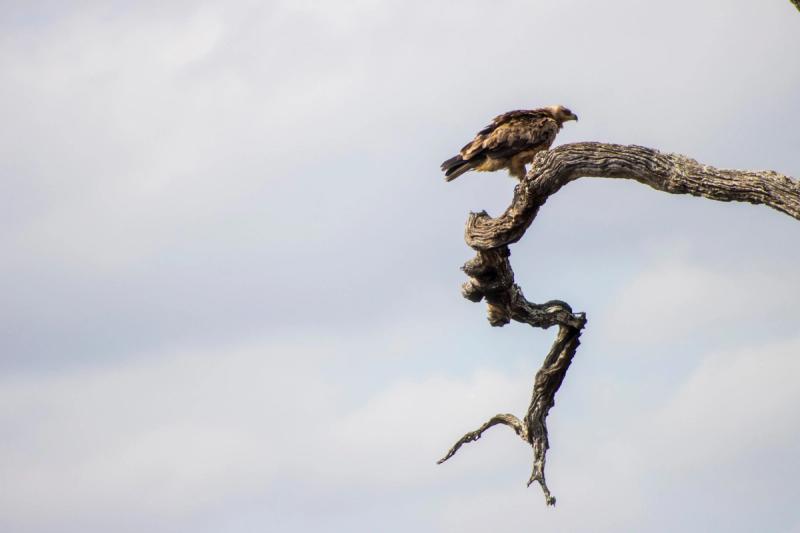
Driving slower than the previous day, we spotted plenty of giraffes, zebras and bucks on our way to Gudzani dam. Around a particularly dense bushy bend, we found Pumbas (warthogs) and a few monkeys but no big cats. At the dam, we were greeted by some happy hippos taking an afternoon dip and a few fish eagles lurking close by. We struck by their magnificent size as one stretched it wings, flapped three times and flew off.
From the S100 route, we decided to follow S41 and take the long scenic loop back to Satara along the the S90. We soon encountered the Kruger's great wildebeest migration. A herd, close to 100 strong, slowly making its way across the open plains. Around another corner we found ourselves slowing from 25km per hour to a 15km crawl as a large bull elephant leisurely strolled on the road in front of us. We kept our distance for the 500 metres he decided to plod along the main road before turning off.
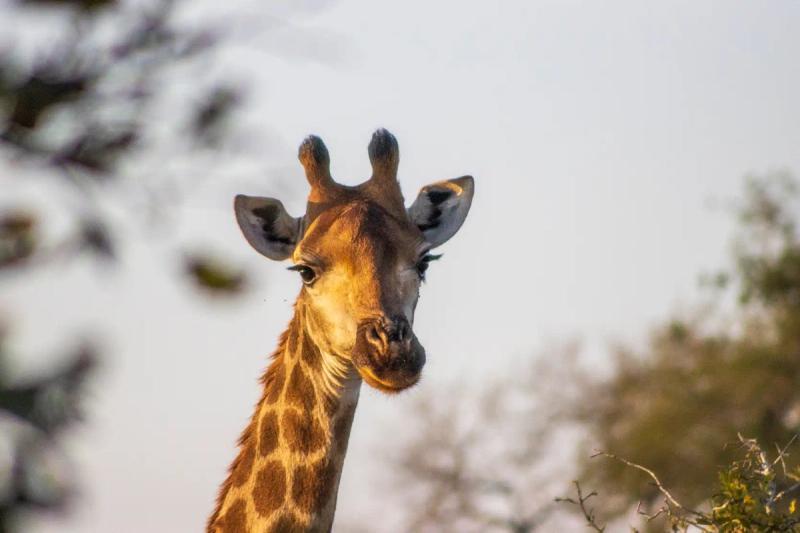
Finally able to get to a more comfortable speed, we saw a car stopped in the distance. Without a lion, leopard or cheetah sighting under our belt, we hoped for the best and sped up slightly convinced we might miss whatever had caught their eye if we weren't quick enough. Slowing back down behind them, we excitedly scanned the horizon only to find a large flock of ostriches looking back at us!
They might have been captivated by this sighting but as locals, it was a picture we'd seen countless times and so we headed back at our campsite. After an early dinner, we took a stroll around the camp and found our path being crossed by fierce feline: the mighty but small African Wild Cat.
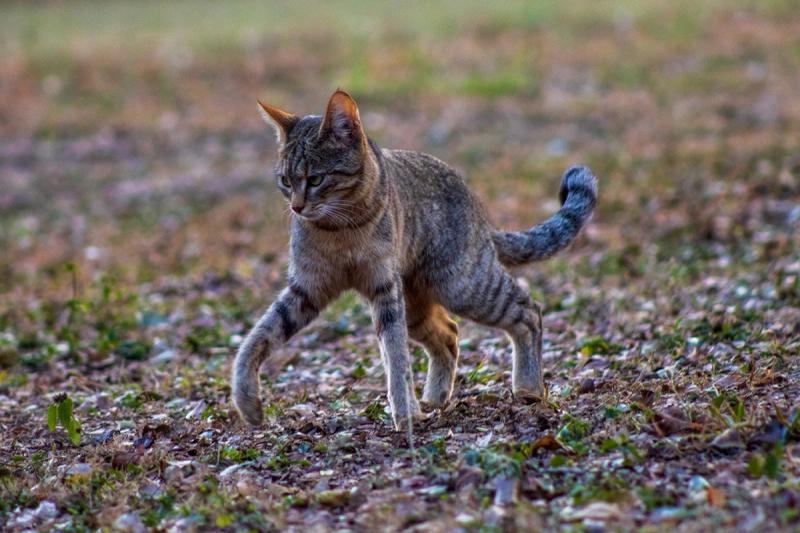
Olifants day loop
On our second full day at Satara, we set off early turning left away from everyone else and doing the Olifants loop along the river towards Olifants Rest Camp. We'd hoped that by going the path less travelled, we'd be rewarded by spectacular sightings. We weren't but we enjoyed the journey all the same, seeing plenty of buck, giraffes and zebras as the sun painted them gold.
Along the river that dots the S39, we spotted a few more hippos and our first crocodile as well as some storks. We decide to stop in a bird hide, something we repeated a few times after, soaking up the sounds of nature before continuing along the river. Eventually, we passed over the first of the two Olifant bridges, the view beckoning us to stop and get out of our car (one of the few places you're allowed to within the park).
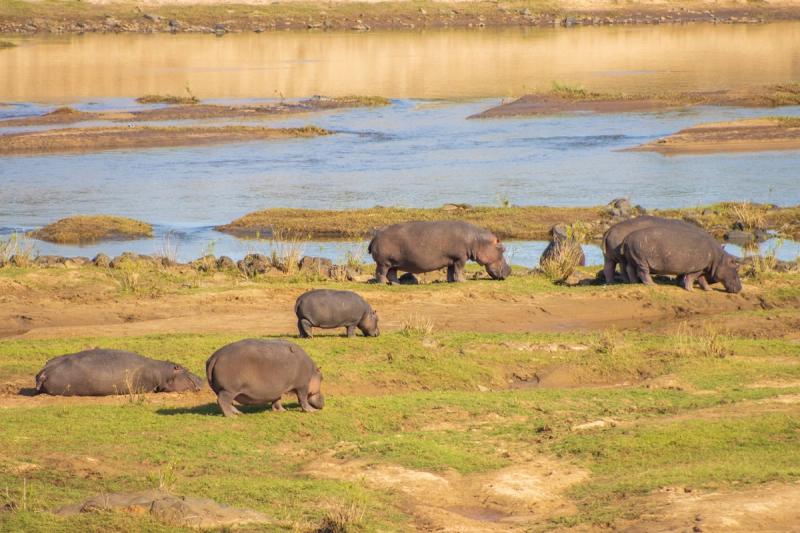
From our vantage point on the bridge, we watched a large herd of elephants with the tiniest, days old baby meandering along the riverbank, over one end of the bridge and into the thicket. We stayed a few more minutes, absorbing the the archipelago of little islands broken up by numerous arms of waterways before making the final stretch to Olifants Rest Camp. There, we had a quick snack before heading back a different loop and spotting our first hyena of the trip. It ran alongside the car, heading in the opposite direction.

Gudzani Plains loop
Our third and last full day at Satara started off uneventful and a little disappointing with two missed leopard sightings. We went back along the S100 route to the Gudzani dam where even more hippos than the first day greeted us. From there we travelled along the S41 to the Nwanetsi picnic spot and saw a car stopped alongside a particularly tall, grassy area. They told us that a leopard had been spotted there not long ago but after five minutes of craning our necks, scanning the grass we decided to head on to the rest stop where we could stretch out legs and use the facilities.
There, we met a private safari guide who told us they'd been circling the area the leopard had been spotted and found it. We followed his car to a bird hide where we saw a tortoise and several crocs. We decided to leave this knowledgeable guide and head back to Satara along H6 and finally have breakfast.

Having finished our meal, and headed for a quick power nap, we bumped into the same guide who asked if we'd seen the leopard. We discovered that they'd left only minutes after us and had seen a leopard chase a porcupine! Slightly disappointed, we consoled ourselves with the knowledge that that was just the luck of the draw in the wild.
We had an early dinner that night, in preparation for our sunset guided safari which turned our uneventful day into one of the best ones we'd had. As the food cooked, a honey badger waltz on past us, undeterred by our presence.
Bush Walk
For our first full day inside the Kruger Park, we’d booked a guided sunrise bush walk. This meant getting up at 4.30am, which even for a self-proclaimed early-bird like myself was a bit of a challenge. Underdressed (on my part at least), I shivered away as the open air safari vehicle sped down the road. Roaming the outskirts of our rest camp in the freezing clutches of the pre-dawn night were honeybush badgers, a serval, a jackal and a sweet little bunny hopping about.
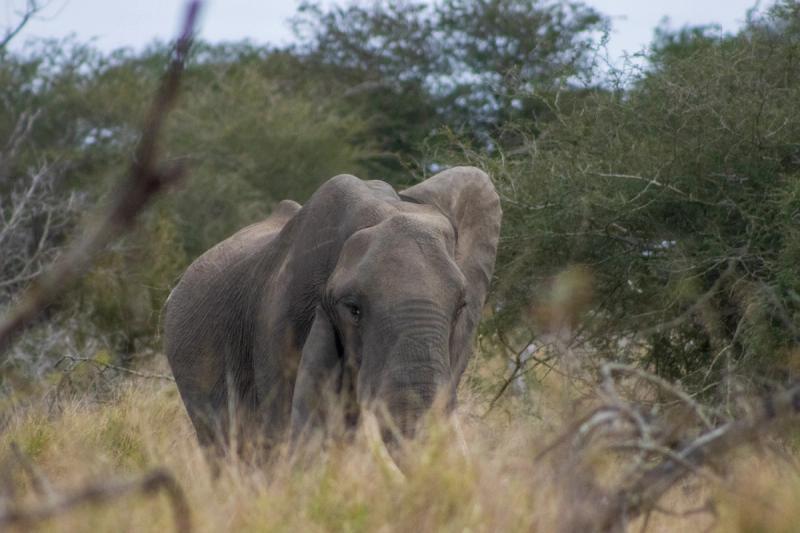
After driving around for half an hour, we parked near the Nsemani dam and began our three hour loop. Our guides showed us how to identify different tracks, showed us the different types of poop. White feces indicate a high calcium intake and come from lions, leopards, hyenas and crocodiles. Our group, my mother and myself excluded, spotted a tiny owl in the distance.
While our walk was mostly uneventful, we did come close to an unhappy and injured elephant. His ear was damaged and ever sound seemed to agitate him. We were told to keep quite and to stay as still as possible until he returned to his herd, who were just out of sight. As he turned, we cautiously made our retreat.
Not long after our close call, we stopped for snacks provided by the rangers. I felt slightly light headed, the lack of sleep finally catching up with me. We chatted among ourselves and asked the rangers questions before circling back. Driving to Satara, we saw our fish eagle perched majestically on a branch, high up above the world.
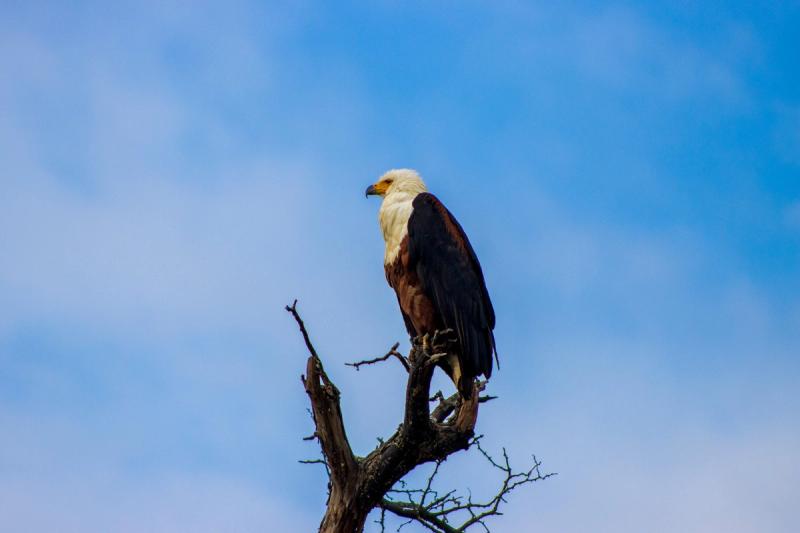
Sunset Safari
Our last day at Satara before heading south and closer to the gate, ended with a sunset safari drive. And boy was it spectacular. Driving along, we passed by another safari vehicle. We couldn't hear what our driver and the driver of the other vehicle were discussing but our excitement was growing especially at the mention of a carcass. Whatever it was, we headed there quickly.
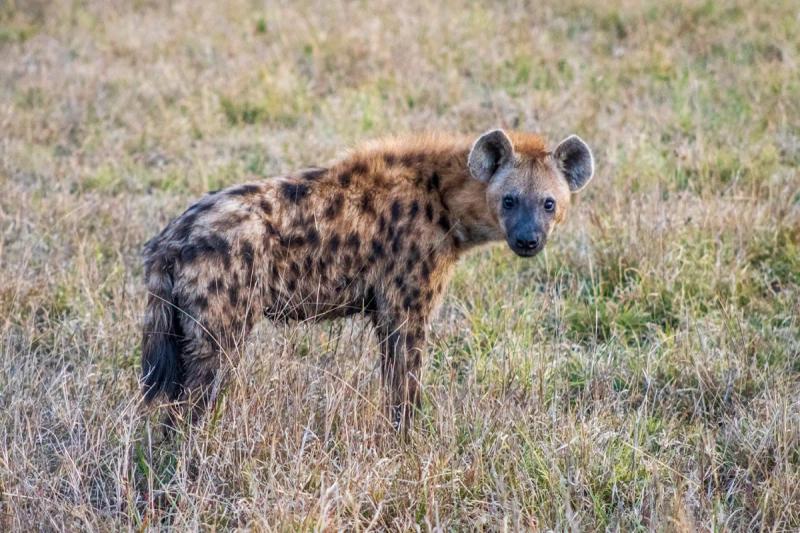
First we spotted a hyena then another and another. Driving closer, we then spotted a male lion resting lazily on a small sandy ledge, his belly presumably full. Nearby a few jackals scoped the area, surely hoping to scavenge whatever the lions and hyenas left. Some metres away, our driver spotted a female lion and cub and told us that they were guarding the carcass. The hyenas were waiting patiently for the lions to leave their kill and after snapping hundreds of photos, we eventually returned to our seats having stood and moved to one side of the vehicle to get better photos. As we turned to leave the feasting felines in peace, a large troop of elephants came over the hill in the other directions. Their trunks in the air, as it turns out, sniffing the potential danger that lurked nearby.
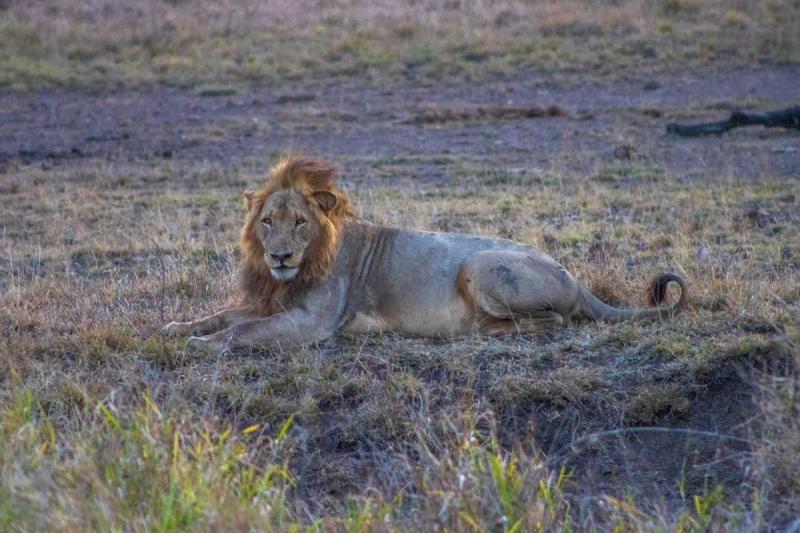
We watched the elephants make a bee-line for where the lions and their carcass lay. They approached fast, trumpeting as they went, and scaring the predators away. We watched, absorbed in the politics of the wild as the herd kept its youngest members securely in the middle and a strong young elephant charged at one of the hyenas that had been bold enough to stay. The female lion and her cub were quick to disappear but the hyenas remained nearby, somewhat less deterred. The male lion stayed where he was, observing all from his thrown.
Driving back, we watched the last of the light disappear and darkness take hold. We spotted a lone elephant bull alongside the road. Flapping his ears and stomping his feet, he made it known that our presence was an unwelcome one so we slowly crept past. Our journey back was filled with hares hopping out the way, African wild cats darting into the bush and another male lion, younger and alone this time.
